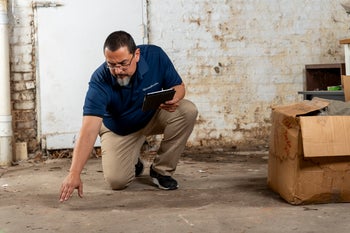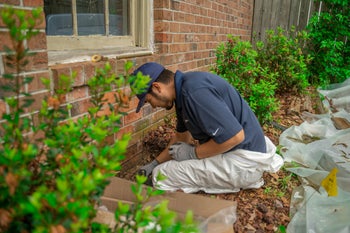How to Remove Standing Water in Your Basement
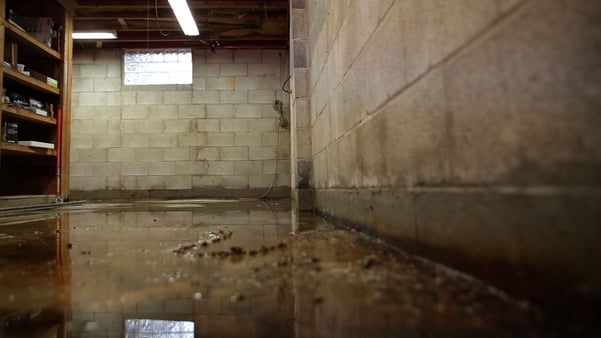
Finding standing water in your basement can turn an ordinary day upside down. Maybe you discovered it during a routine trip downstairs or noticed a musty smell that made you investigate further. Either way, you’re now facing more than just an inconvenience.
Standing water threatens your home’s structural integrity, creates unhealthy conditions, and destroys personal belongings.
This page covers how to address standing water and prevent it from returning with basement waterproofing solutions that last.
Why You Shouldn’t Ignore Standing Water in Your Basement
Standing water in your basement is more than just a messy inconvenience. Even a few inches can weaken your foundation over time and create a damp environment where mold thrives, putting your family’s health at risk. If not addressed promptly with proper repairs, these seemingly minor issues can lead to the following:
- Causes structural damage and weakens foundation walls: Basement water causes damage, such as concrete erosion and weakened materials. Over time, this can lead to cracks, shifting, and even basement wall bowing.
- Encourages mold and mildew growth: Damp conditions create the perfect environment for mold growth and mildew. This growth can cause allergies, respiratory problems, and poor indoor air quality.
- Damages personal belongings and utilities: Stored furniture, boxes, and appliances are easily ruined by water exposure. Basement HVAC systems and electrical components are also at risk.
- May impact home value: Persistent moisture problems can lower your property’s value and curb appeal.
Addressing standing water promptly helps you avoid major repairs and protect your family’s health.
What Causes Standing Water in a Basement?
To address standing water properly, you first need to understand what’s causing it. In most cases, it results from a combination of surface water, soil conditions, and structural issues, including:
Poor Drainage
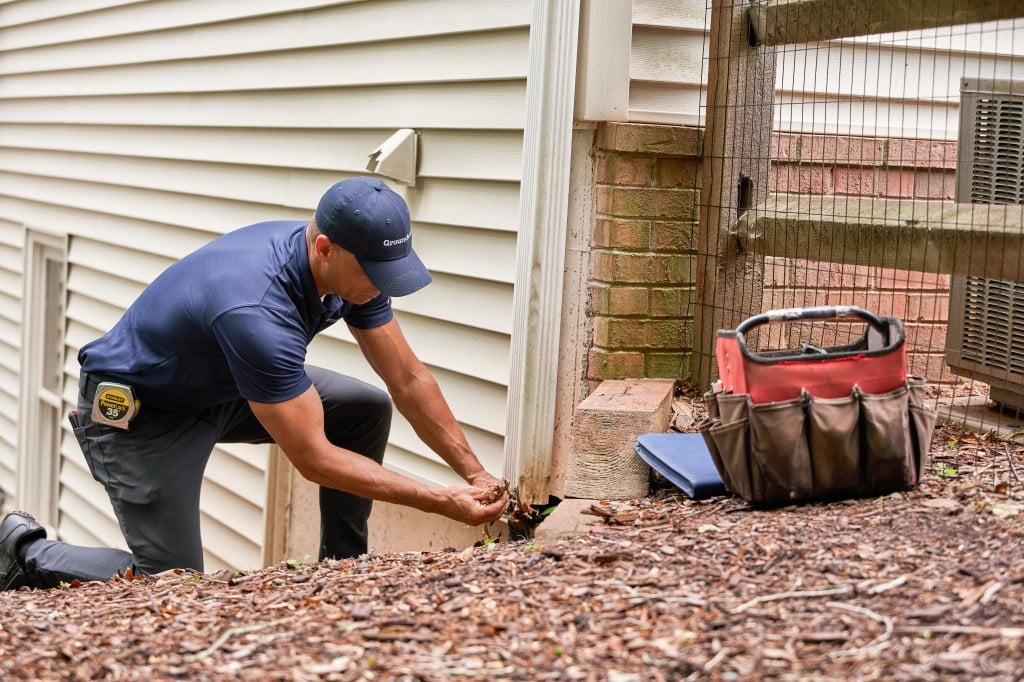
- Improper Yard Grading: If the soil around the foundation slopes toward your home, water will drain against the foundation rather than away from it. This improper landscape grading causes soil erosion, hydrostatic pressure, and water seepage.
- Clogged or Ineffective Gutters and Downspouts: Debris-filled gutters will overflow, and downspouts that discharge too close to the house can saturate the ground near the basement walls. This poor drainage causes water seepage, bowing walls, and other problems.
Hydrostatic Pressure
- Saturated Soil: Excessively wet or flooded soil increases pressure against your basement walls and floors. After heavy rain or snowmelt, this hydrostatic pressure can build up and press against the foundation.
- Water Seepage: That pressure can force water through even small cracks or gaps in the concrete, allowing moisture to seep in and collect as standing water.
Water Leaks

- Broken or Leaking Pipes: A leaking pipe or fitting can slowly flood your basement.
- Malfunctioning Sump Pumps: A failed sump pump allows water to collect, while water heaters can leak and expel water onto the floor.
Foundation Cracks

- Vertical or Horizontal Cracks: Foundation cracks from soil erosion, voids, and hydrostatic pressure allow water intrusion into the basement.
- Expansive Soil Movement: Natural settling or expansive soil can shift and crack the foundation, opening pathways for moisture.
- Frost Heave: Canadian winters bring freezing temperatures, and the expansion of water in the soil (frost heave) can put additional stress on foundations. This pressure leads to cracks and pathways for water intrusion during thaws.
Knowing the source of the problem is vital for choosing the best repair method and preventing future damage.
What to Do When You Discover Standing Water in Your Basement
Proactive measures can reduce water damage and lower repair costs. Take these steps as soon as you notice water in your basement.
Ensure Safety First
Before entering a flooded basement, turn off the electricity at the main panel to prevent the risk of electric shock. Water and electricity are a dangerous combination. Be sure to wear protective gear, including boots, gloves, and a mask, to guard against contaminated water and mold exposure.
For your safety, consider contacting a professional to inspect the area and assess any potential hazards.
Identify the Water Source
Check for signs of foundation leaks, plumbing failures, or outdoor drainage problems. Identifying the source will help you determine whether you’re dealing with a one-time issue or an ongoing problem that needs long-term solutions.
Remove the Water
Remove standing water using a wet/dry vacuum or a sump pump, which are most effective for several inches of water. For smaller amounts, buckets and mops may be sufficient to manage puddles. Always dispose of the water away from your home’s foundation to avoid worsening any existing drainage problems.
Responding quickly can minimize damage and mold risk, keeping cleanup manageable.
How to Dry Out Your Basement
Once the standing water is gone, the next step is to dry out the basement thoroughly. Removing all moisture helps prevent mold and further structural issues.
Remove Wet Items
Remove furniture, rugs, and boxes from the basement to prevent mold growth, as porous items can retain moisture and lead to contamination. For storage, use plastic bins instead of cardboard, which easily absorbs moisture and deteriorates, increasing the risk of mold.
Increase Ventilation
Open the egress windows and use fans to circulate air, as increased airflow helps speed up the drying process. Adding a dehumidifier further reduces excess moisture and humidity, helping to prevent future mold growth.
Disinfect the Area
Clean basement walls and floors with a bleach solution or commercial cleaner to kill any mold spores or bacteria that may be present. Ongoing cleaning and monitoring can help prevent mold and bacteria from spreading unnoticed.
Remember: A dry basement is a safe basement. Take the time to remove the moisture in all areas.
How to Prevent Basement Water Intrusion
After cleanup, reducing the risk of future water problems is essential. Preventative solutions will save you time, money, and stress later. Here’s how to prevent water intrusion:
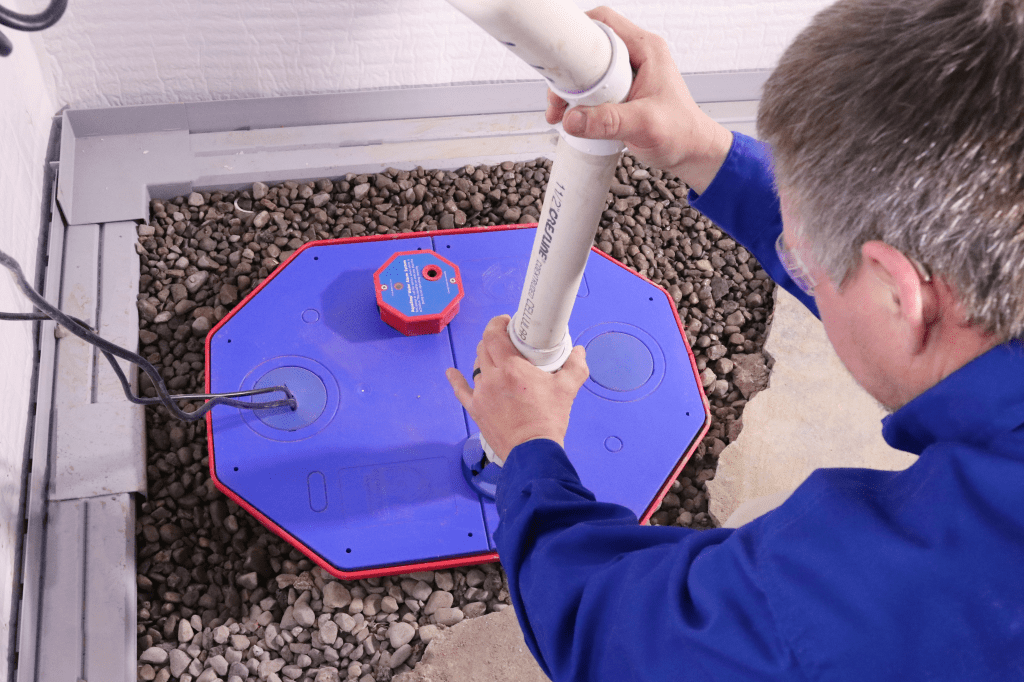
- Install a Sump Pump: Ensure your basement sump pump functions properly and has a battery backup to keep it running during power outages. Clean the sump pit regularly to prevent debris from clogging the system and affecting performance.

- Apply a Vapor Barrier: A waterproof vapor barrier liner helps block wall water seepage. This moisture barrier is especially important in humid, flood-prone areas or those at risk of hydrostatic pressure due to flooding.

- Install a Dehumidifier: A basement dehumidifier reduces humidity levels, making it more difficult for mold and mildew to grow. It also supports overall moisture control and air quality.

- Implement an Interior Drainage System: These interior gutter drainage systems collect water inside the basement perimeter and direct it to the sump pump for removal. They are effective for managing water that gets past exterior defenses.

- Install Basement Insulation Panels: Proper thermal insulation helps regulate temperature and prevent condensation. It also protects against moisture buildup that can lead to mold and mildew problems.
Additional Ways to Protect Against Water Seepage
- Clean Gutters and Extend Downspouts: Ensure gutters are clean and securely attached. Overflowing or sagging gutters can dump water too close to the foundation, causing water accumulation near the foundation. Extend downspouts at least 10 feet from the house to keep roof runoff from pooling near the foundation and seeping into the basement.
- Improve Yard Grading: Proper grading helps direct rainwater away from basement walls and reduces the risk of water intrusion. Ensure the soil around your home is graded to slope away from the foundation.
- Seal Foundation Cracks: Use epoxy injections or polyurethane sealants to close small cracks in basement walls and floors. This sealing prevents water intrusion and stops existing cracks from worsening.
Investing in permanent solutions, like basement waterproofing, helps prevent expensive repairs and more extensive foundation damage.
When to Call a Basement Waterproofing Professional
Sometimes DIY solutions just aren’t enough. Here’s when it’s time to call a professional:
- Structural Damage or Foundation Cracks: Visible cracks in walls or floors may indicate deeper foundation issues. A professional can assess the damage and recommend appropriate structural repairs to prevent it from worsening.
- Extensive Mold Growth: Mold that spreads across large areas can threaten your health and home. Certified remediation specialists have the tools and training to remove mold safely and prevent it from returning.
- Persistent Water Problems: If water continues to return despite repeated DIY efforts, a professional can identify the underlying cause and offer a long-term solution.
- Need for Advanced Waterproofing or Drainage Systems: Installing interior drainage systems, sump pumps, or comprehensive waterproofing solutions often requires specialized equipment and knowledge. A professional inspection reveals hidden issues and ensures the right systems are in place to keep your basement dry long-term.
Contact Groundworks and Say Goodbye to Standing Water

Standing water in your basement is a serious issue, but with the right approach, it’s completely manageable. Remain proactive with regular maintenance and know when to call for professional help.
Groundworks’ basement waterproofing experts are ready to help when you need them most. A dry basement protects your home’s value and provides the peace of mind you deserve.
Schedule your free inspection with us today.
Basement Waterproofing FAQs
Most homeowner’s insurance policies provide coverage for water damage resulting from events such as burst pipes, sink or bathtub overflows, and leaks from water heaters, dishwashers, or washing machines. However, these policies typically do not cover basement or foundation damage caused by heavy rainfall, storms, mudslides, sinkholes, or underground water seepage. In such cases, separate flood insurance coverage becomes necessary to safeguard against these types of water-related incidents.
It’s time to consider installing or upgrading your sump pump if you notice problems like water in your basement, mold, efflorescence, musty odors, and elevated humidity. These issues will not resolve themselves; contact Groundworks for a free inspection and sump pump estimate.
While a single dehumidifier may seem sufficient for a basement space, conventional residential models often lack the capacity to effectively remove excess moisture from the entire area. Multiple small units can drive up energy costs. Instead, invest in a professional dehumidifier designed to remove up to 100 pints of water per day while operating efficiently, providing comprehensive moisture control tailored specifically for basement environments.

